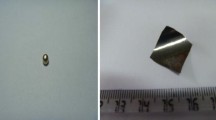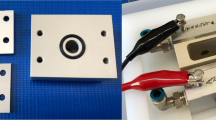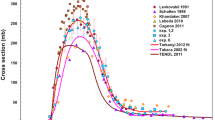Abstract
This paper describes present capabilities of the new Target Preparation Laboratory constructed at Horia Hulubei National Institute for Physics and Nuclear Engineering, Bucharest-Magurele, Romania. Self-supporting or backed targets are produced in the laboratory, using thermal evaporation, electron-gun evaporation, sputtering or cold rolling techniques. At present, it is possible to prepare layers with a wide range of thicknesses from several tens of µg/cm2 to several hundreds of mg/cm2. As an example, we briefly describe a 40Ca target preparation.
Similar content being viewed by others
Avoid common mistakes on your manuscript.
Introduction
The Target Preparation Laboratory was commissioned in 2013 at Horia Hulubei National Institute for Physics and Nuclear Engineering (IFIN-HH), Bucharest, Romania. The laboratory was created in order to support the nuclear physics research activity performed mainly at the 9 MV FN tandem accelerator in IFIN-HH, and other international research facilities where the research groups have scientific collaborations. This laboratory provides enriched isotopic targets for different types of nuclear structure experiments, such as measurements of lifetimes of excited nuclear states using different γ-ray spectroscopy techniques (Doppler shift attenuation, plunger, and fast-timing), nuclear structure studies using the activation technique and cross-section measurements of interest for nuclear astrophysical processes.
The success of the nuclear physics experiments is strongly influenced by the characteristics of the obtained target (purity, composition, thickness, uniformity, etc.). To assure good target quality, the target laboratory was equipped according to international standards set for this type of target laboratories [1–12].
In general, a target request specifies characteristics like: isotopic material, thickness, and target frame type. Design of the target frame determines the target surface area and shape (Fig. 1). One should also mention the type of target to be made (e.g. self-supporting, backed or sandwiched). In case of the backed targets one should specify the backing characteristics (material and thickness).
Equipment for target preparation
The laboratory is equipped with two evaporation systems that are further described along with their design specifications (capabilities).
TE18-High Vacuum Deposition System, as shown in Fig. 2, is a physical vapor deposition device, used for creating self-supporting or backed targets by thermal evaporation, by electron-gun evaporation, or by sputtering. This vacuum deposition system is also used to produce targets by reduction-distillation method.
The system features a stainless steel cylindrical chamber (45 cm diameter and 53 cm high), placed on the top lid together with the rotary heater and the substrate (see Fig. 2B: a). The heater of the system is specially configured to reach a maximum temperature of 700 °C. The chamber includes a frontal 4-inch viewport that is placed in an ISO-KF DN100 flange. The chamber has a motorized hoist to raise and lower the top lid and the vacuum chamber.
Vacuum components are mounted on an “open architecture” chassis and the power supply and the control modules are placed on an independent cabinet. The setup is equipped with a high-vacuum system capable of pumping down the chamber to a pressure level below 3.5E−5 Torr in <1 h.
The system has also one resistive evaporation kit (Fig. 2B: b) with a 3.6 kW power supply (6 V and 600 A) for evaporation of materials with melting points not higher than 1,800 °C.
For making targets of high melting point materials (up to 3,800 °C) and dielectrics, the system is equipped with an electron-gun and a 4-pocket × 2 cc volume rotary water-cooled copper crucible which allows sequential evaporation of up to 4 materials (Fig. 2B: c). The electron-gun has a 270° deflection angle, 5 kV acceleration voltage and 600 mA maximum current. The system is equipped with a XY sweep controller.
The equipment contains a 2.5 cm diameter water-cooled magnetron-sputtering source (Fig. 2d), mounted in the base plate of the chamber. The magnetron source is powered with a 300 W RF power supply and a 13.54 MHz plasma generator with manual matching network.
The system has an Inficon SQM160 Thin Film Deposition Monitor (Fig. 2B: e) for monitoring the thickness of the deposited material and the rate of deposition.
The second system is a Quorum Technologies E6700 Bench Top Evaporator, as shown in Fig. 3, equipped with power supplies for both carbon and metal evaporation. It includes sputtering, glow discharge, low angle shadowing, and film thickness monitoring. The work chamber with a diameter of 30 cm can be evacuated to less than 10−5 mbar. In standard operation we apply up to 10 V at 200 A for carbon coating and 20 V at 100 A for metal evaporation.
In addition, the target laboratory is equipped with an electrically controlled Durston type DRM 100 rolling mill with variable speed (Fig. 4). The rolls have a size of 100 × 50 mm and are made of specially selected roll steel, heat-treated on the main working surface.
Auxiliary equipment is also used to provide support for the numerous other activities required for target fabrication. Most targets produced in the laboratory are characterized, with regard to their thickness, by α transmission using an α source containing a mixture of 241Am and 244Cm. The energy spectra of the transmitted α-particles through the studied foils are measured with a totally depleted silicon detector [13]. Obtained thicknesses are also checked and usually found consistent with the ones determined by weighing and dividing by surface area. For this purpose the laboratory is currently equipped with a dual range analytical balance (Mettler Toledo XS205) which allows to weight samples at different resolutions. A tube furnace, which can be operated at temperatures up to 1300 °C, is used for chemical processing of isotopic material. To prepare pellets from powder isotopic material used further for vacuum evaporation or reduction, a 5 t hydraulic press is used in conjunction with hardened steel dies. An inert-gas glove box (Labconco) is available for handling of targets that may oxidize quickly. Targets are generally stored in vacuum desiccators containing desiccant, usually silica gel, which keeps the contents clean and free from moisture.
Produced targets
Based on the capabilities of the target laboratory, several enriched isotopic targets were produced during the last 2 years (Table 1). Thin-films were obtained according to different procedures described in INTDS literature [14–36].
An example of a more special target preparation is described in the following.
Preparation of sandwiched 40Ca target
For lifetime measurements by the recoil distance Doppler shift (RDDS) method (plunger method) it is necessary to obtain very smooth targets without points or wrinkles when streched. In this case 40Ca (0.3 mg/cm2) targets gold backings (4.5 mg/cm2) were required, as depicted in Fig. 5 [17, 32, 33].
The 40Ca target was prepared through a reduction-distillation method starting from CaCO3 powder and with Zr metal powder as reducing agent. In order to produce metallic 40Ca, about double the stoichiometric amount of high purity Zr metal powder was thoroughly grinded together with the required amount of CaCO3, in an agate mortar set. Obtained mixture was pressed into a pellet, which was then broken to smaller pieces and inserted into a pinhole tantalum-boat. Both ends of the boat were pressed flat and fixed to the high current electrodes of the evaporation device (TE18).
A 4.5 mg/cm2 gold foil prepared by rolling was glued to the plunger target frame, as depicted in Fig. 1b) and stretched over a cone. This gold backing was placed 4.5 cm above the tantalum-boat in the evaporator. It is crucial to get the appropriate distance between the source and the substrate, as this mainly determines the final thickness of the target.
After achieving a vacuum of 3.5 × 10−5 Torr at first a low current was applied through the tantalum-boat to assist the degassing of CO2 which is released at ~850 °C. The current through the tantalum-boat was maintained at this level until stabilization of the vacuum. Then, the current was slightly increased until the reduction temperature of 1,350 °C was reached. The evaporation process was carried out until the desired thickness was obtained, measured with the quartz deposition monitor, previously calibrated during tests with natural material.
Obtained 40Ca layer was covered with a thin gold layer of 0.1 mg/cm2 without breaking the vacuum, to protect the metallic 40Ca against oxidation. This deposition was made with a tungsten basket, fixed at 9 cm distance above the substrate. In order to achieve good uniformity of the obtained layers, the substrate was rotated during all evaporation processes.
Sandwiched 40Ca target was used to measure the lifetimes of several excited states in 44Ti using the RDDS technique with the Bucharest plunger device coupled to the γ-spectroscopy array comprising HPGe and LaBr3(Ce) detectors [37]. The target was kept in beam for 7 days, to cover a sufficient range of lifetimes and statistics in order to calculate lifetimes with high precision.
After the whole 7-days experiment the target did not suffer any surface modification.
Conclusions and perspectives
Targets for nuclear physics experiments performed at IFIN-HH laboratories are prepared in a dedicated target laboratory. The films are produced by thermal evaporation, electron-beam evaporation, sputtering and cold rolling. At present, it is possible to prepare layers with thicknesses ranging from several tens of µg/cm2 to several hundreds of mg/cm2. The targets prepared during 2013–2014 (Table 1), from a wide range of chemical elements and compounds, had characteristics that perfectly answered the requirements of the experiments.
To meet the demands of the experiments even better, the Target Preparation Laboratory will develop new target preparation recipes taking into account the different physical and/or chemical properties of the raw materials. Additional characterization methods (e.g. PIXE, PIGE, RBS, AFM, and SEM-EDX) will be employed to determine the features of the obtained targets. To increase the yield of the reduction-distillation processes, a water-cooled substrate set-up will be installed inside the vacuum chamber of the TE18-High Vacuum Deposition System. Plans are in progress to further develop a target storage facilities that will then allow storage of the most reactive targets under high vacuum or controlled inert atmosphere. A more powerful electrical double-sided rolling mill will also be purchased.
References
http://npg.dl.ac.uk/NPG/target_manufacture.htm. The target laboratory at Daresbury Laboratories, UK
http://www.phy.anl.gov/targetlab. The target laboratory at Argonne National Laboratory (ANL), USA
http://www.gsi.de/informationen/wti/tl/index_e.html. The target laboratories at Gesellschaft für Schwerionenforschung (GSI), Germany
Sapir L (1982) Nucl Instrum Methods 200:121–122
Gallant JL, Dmytrenko P, Martin RH (1982) Nucl Instrum Methods Phys Res A236:456–462
Ueta N, Engel WGP (1989) Nucl Instrum Methods Phys Res A282:188–190
Greene JP, Thomas GE (1989) Nucl Instrum Methods Phys Res A282:191–193
Pengo R (1989) Nucl Instrum Methods Phys Res A282:180–184
Greene JP, Neubauer J, Deligiannis D (2006) Nucl Instrum Methods Phys Res A 561:58–61
Morrall PS (2008) Nucl Instrum Methods Phys Res A590:118–214
Morrall PS (2010) Nucl Instrum Methods Phys Res A613:423–424
Petitbon-Thevenet V (2010) Nucl Instrum Methods Phys Res A613:419–422
Cata-Danil I, Filipescu D, Ivascu M, Bucurescu D, Zamfir NV, Glodariu T, Stroe L, Cata-Danil G, Ghita DG, Mihai C, Suliman G, Sava T (2008) Phys Rev C 78–035803:1–8
Maxman SH (1961) Nucl Instrum Methods 50:53–60
Reynolds JB (1965) In: Proceedings of the seminar on the preparation and standardisation of isotopic targets and foils
Heagney JM (1972) Nucl Instrum Methods 102:451–455
Heagney JH, Heagney JS (1976) Proceedings of 15th Annual Conference of the INTDS
Kobisk EH, Adair HL (1979) Nucl Instrum Methods 167:153–160
Risler R, Hinn GM, Hoffman SA (1982) Nucl Instrum Methods 200:43–44
Zell KO, Dewald A, Geuer A (1980) INTDS Newsletter 203–211:12–13 (1 February)
Zell KO (1981) INTDS Newsletter 253–262:13 (1 April)
Zell KO (1981) INTDS Newsletter 263–268:2 (2 December)
Zell KO (1982) INTDS Newsletter 315–322:6 (1 June)
Zell KO (1981) INTDS Newsletter 323–324:10 (2 December)
Zell KO (1983) INTDS Newsletter 325–335:5 (1 August)
Zell KO (1983) INTDS Newsletter 336–340:17 (2 December)
Pengo R, Favaron P, Manente G, Cecchi A, Pieraccini L (1991) Nucl Instrum Methods Phys Res A303:146–151
Green JP, Thomas GE (1991) Nucl Instrum Methods Phys Res B61:575–579
Kheswa NY, Buthelezi EZ, Lawrie JJ (2008) Nucl Instrum Methods Phys Res A590:114–117
Anderson CG (2012) Chem Erde 72:3–8
Green JP, Pawlak A, Zhu A, Garg U (2014) J Radioanal Nucl Chem 299:1125–1128
Kobisk EH, Grisham WB (1969) Mater Res Bull 4:651–662
Henning W, Liu Z, Lucas HF, Thomas GE, Adair HL, Grisham WB (1987) Nucl Instrum Methods Phys Res A257:60–63
Greene JP, Palumbo A, Tan W, Görres J, Wiescher MC (2008) Nucl Instrum Methods Phys Res A590:76–78
Qiwen F (2010) Nucl Instrum Methods Phys Res A613:386–388
Kheswa NY, Papka P, Buthelezi EZ, Lieder RM, Neveling R, Newman RT (2010) Nucl Instrum Methods Phys Res A613:389–391
Michelagnoli C, Ur CA, Farnea E, Lenzi S, Lunardi S, Recchia F, Marginean N, Bucurescu D, Cata-Danil G, Deleanu D, Filipescu D, Ghita D, Glodariu T, Marginean R, Mihai C, Negret A, Pascu S, Sava T, Stroe L, Suliman G (2011) Acta Phys Pol B 42:825–828
Acknowledgments
The authors would like to thank Mr. Massimo Loriggiola, target engineer at the INFN-LNL Laboratory, Italy and to Dr. Karl-Oskar Zell at the Institut für Kernphysik der Universität zu Köln, for their advice and support. The target laboratory commissioning was possible due to support through the 7PM/1/2008/9.10.2008 capacity UEFISCDI—Romania Project. The work has been funded by the Sectoral Operational Programme Human Resources Development 2007–2013 of the Ministry of European Funds through the Financial Agreement POSDRU/159/1.5/S/132397.
Author information
Authors and Affiliations
Corresponding author
Rights and permissions
About this article
Cite this article
Florea, N.M., Stroe, L., Mărginean, R. et al. The status of the Target Preparation Laboratory at IFIN-HH Bucharest, Romania. J Radioanal Nucl Chem 305, 707–711 (2015). https://doi.org/10.1007/s10967-014-3899-y
Received:
Published:
Issue Date:
DOI: https://doi.org/10.1007/s10967-014-3899-y









